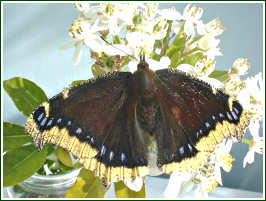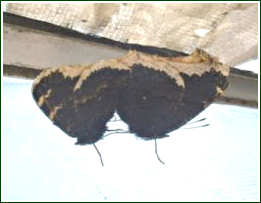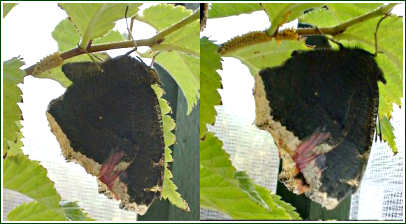Raising Mourning Cloaks
Some Questions Answered...
by Nigel Venters & Melanie McCarthy
Q. I collected 7 pupae last week, and I've attached them to the laundry basket cage that I read about in the Secrets... book. It looked like Mourning Cloak pupae, but I wasn't certain. This morning I am the proud mother of my first emerged butterfly,,. and it IS a Mourning Cloak. Now what do I do? Can I feed her on gatorade? Does anyone out there know about raising them in captivity?
*******************************************
 Mourning Cloak Mourning Cloak |
here we call them the Camberwell Beauty...a much nicer name I think after the first recorded specimen taken in Camberwell, London, in around 1750...a rural setting then but now under concrete!
I have bred the US specimens and the European specimens and can find no difference...except the Mourning Cloaks from California are more inclined to have a second generation in the year...if you are North of California...and it is already late in the season...My guess is that you will have to keep you butterflies until next spring.
 Mourning Cloaks mating Mourning Cloaks mating |
I then just provide some cut pears apples plums etc on the top of the netting...they will feed from these...you don't need flowers. Then the activity will stop as the weather warms up for summer...they will aestivate...(Sleep)...then keep an eye for them in the fall as you then need to feed them again as they will become quite active again...as the weather gets colder they will go into the egg cartons, cardboard etc to overwinter. I then put the lid on the bin...I usually open it during mild weather here (Although the butterflies are inactive) to allow a little airflow...I just use a couple of bits of wood to hold it clear.
 Mourning Cloak laying Mourning Cloak laying |
Anyway it is a bit of work to get them through until next year...but worth it...I have around 500 Mourning Cloak pupae just now...and they are so easy in the spring....the great thing is that they live for so long and the caterpillars are gregarious...so very rarely suffer from disease...you don't have to sterilise foodplant etc...and just keep them until you need them for a release. They lay an egg batch of around 200-300 eggs...so you'll need a lot of hostplant!
Good luck. Nigel Venters www.butterflyboutique.net
*******************************************
A. I've had my best and largest morning cloaks raised on willow. I would use a large bin with the lid cut out and screening on top. The bottom would be hardware cloth so the frass could go through and this container would sit in another.
I would raise them on my front porch where they did get the morning sun and I would put the willow in water as the tree I got the willow from had very high branches and I couldn't sleeve them. Be very careful because if the leaves dry out, each and every larva seems to find a means of escape and you will find them walking down your driveway.
If I used maple syrup, I would dilute it with water and put a little on a sponge but it would have to be just the right amount as it is sticky. Sometimes I would mix in the diluted mixture and pour it onto the fruit if the fruit was not really ripe, so the mourning cloaks would sit on the fruit and get some diluted syrup. They overwinter nicely in boxes up in the corners.
I have mourning cloak now and have made a little display on the counter of my school in the front office - all about the mourning cloak.
They by far are the easiest butterfly I ever raised, the frass doesn't seem to bother them and I love the hardened and rough chrysalis with it's jagged points. The pupae are very lively also.
Melanie McCarthy www.themonarchy.com
*******************************************
A. I use the dustbin for overwintering the adults...the larvae are best sleeved if you can...otherwise...change the food often and you must allow a good airflow...the larvae are gregarious right up to just before they pupate and do not suffer much from disease...if you rear them in closed/sealed containers you will lose them all. They do like heat and some sunshine to do really well. If using cut food, I wrap some wet cotton wool around the stems and then cover this with cling film as it keeps the leaves fresher for longer.
As for adults...they are only double brooded in the south of their range..California...where the overwintered adults are on the wing early in the year and the first generation are already in Pupae by April. These will then go on to have a second (or more) generation. Further generations can be induced by keeping the adults well fed...flowers, rotting fruit etc and spraying with water...they usually go into aestivation for the hot summer months and start feeding again in the fall just before hibernation. The water spraying and heat seems to trick them that it is ok to have a another brood!
Hope this helps...by the way I usually steer clear of Maple syrup and sticky solutions as the adults can get covered in it and then suffer from having wings stuck etc.
Nigel
*******************************************
Q. Thank you Nigel & Melanie,
Nigel, do you keep them in the plastic dustbin until they pupate, then transfer them to a new one? Do I need to clean the frass as is necesary for the monarchs? Do you use a clear plastic dustbin or an opaque one?
Melanie, do you put the diluted maple syrup on a sponge?
*******************************************
A. Yes, a sponge works great.
I've used just a big bin to raise them in - like the kind you can buy at Wal-Mart and I cut out the center of the lid and putt screening in. I like Nigel's idea of adding the egg cartons, and I use opaque - be careful, if you run out of food, they manage to get out of the box and will crawl what seems like for miles. After they pupate at the top I remove them and let them emerge in another cage.